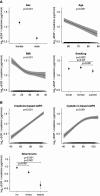Urinary EGF Reflects Distal Tubular Mass and Is Associated with Hypertension, Serum Magnesium, and Kidney Outcomes
- PMID: 39714970
- PMCID: PMC11970850
- DOI: 10.34067/KID.0000000687
Urinary EGF Reflects Distal Tubular Mass and Is Associated with Hypertension, Serum Magnesium, and Kidney Outcomes
Abstract
Key Points:
Donor nephrectomy reduced urinary EGF (uEGF) by half and correlated with the reduction in kidney volume, suggesting that uEGF reflects tubular mass.
In the general population, lower uEGF/creatinine was associated with lower eGFR, lower serum magnesium, and higher BP.
Lower uEGF/creatinine, was associated with incident CKD, and this association was stronger in people without hypertension.
Background: EGF is expressed in the distal tubule and secreted in urine (urinary EGF [uEGF]) after cleavage of membrane-bound pro-EGF. Lower uEGF is associated with kidney disease progression. EGF also plays a role in the regulation of serum magnesium and BP, but whether uEGF is associated with these parameters is unknown. We hypothesized that uEGF is a distal tubule marker associated with serum magnesium, BP, and kidney outcomes.
Methods: We first used a cohort of kidney donors (N=20) and measured uEGF to analyze the association with tubular mass and pro-EGF in urinary extracellular vesicles as proxy for tubular expression. Next, we measured uEGF in a population-based cohort (N=2382) to investigate the associations with serum magnesium, hypertension, and kidney outcomes (incident eGFR <60 or <45 ml/min per 1.73 m2, 40% loss of eGFR, or kidney failure).
Results: Kidney donation decreased eGFR from 86 to 54 ml/min per 1.73 m2 (36% reduction; 95% confidence interval [CI], 31% to 42%), uEGF from 28 to 14 µg/24 hours (49% reduction; 95% CI, 42% to 55%), and pro-EGF by 29% (95% CI, 12% to 45%). The decrease in uEGF correlated with the decrease in kidney volume. In the population cohort, lower uEGF was significantly associated with hypertension and lower serum magnesium. The association between uEGF and serum magnesium was stronger in participants with lower eGFR, hypertension, and diuretic use. Lower uEGF at baseline was also associated with worse kidney outcomes, and this association was stronger for normotensive participants.
Conclusions: uEGF is a marker of distal tubular mass that is not only associated with kidney disease progression, but also with serum magnesium and BP. Future studies should address whether normotensive people with low uEGF excretion represent a group that may benefit from kidney-protective treatment.
Conflict of interest statement
Disclosure forms, as provided by each author, are available with the online version of the article at
Figures






References
Grants and funding
LinkOut - more resources
Full Text Sources
Research Materials
Miscellaneous

